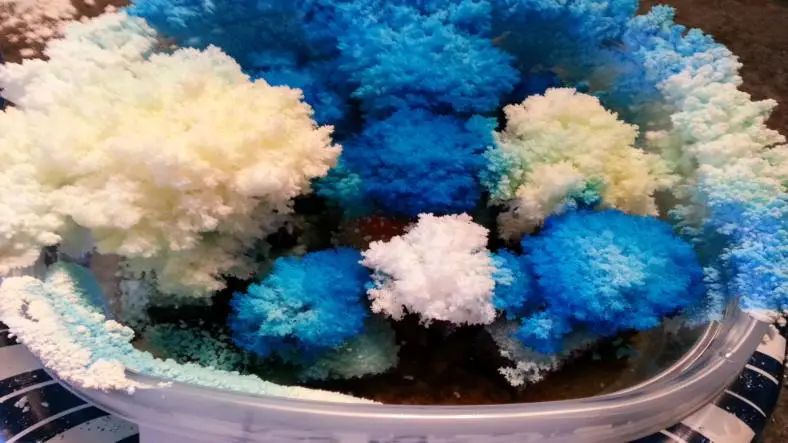Creating a salt crystal garden is a fascinating and educational science experiment that allows children to observe crystal formation and learn about solubility, saturation and crystallization.
Here's a step-by-step guide:
Materials:
- Wide-mouthed glass or plastic container (such as a jar or bowl)
- String, yarn, or pipe cleaners
- Scissors
- Salt (Epsom salt or table salt)
- Water
- Food coloring (optional)
- Small decorative items (optional)
- Spoon or stirring stick
Procedure:
- Clean and dry the container thoroughly. Choose a wide-mouthed container that allows plenty of surface area for crystal growth.
- Create Hanging Structures:
- Cut pieces of string, yarn, or pipe cleaners into lengths that can hang inside the container. These will serve as the surfaces for crystal growth.
- If using pipe cleaners, shape them into interesting designs or figures.
- Prepare the Salt Solution:
- Heat water in a saucepan or microwave-safe container until it's hot but not boiling.
- Gradually add salt to the hot water, stirring continuously, until no more salt dissolves. This creates a supersaturated salt solution.
- Optional: Add a few drops of food coloring to the solution to create colored crystals.
- Submerge Hanging Structures:
- Lower the string, yarn, or pipe cleaner structures into the salt solution, ensuring that they are fully submerged and do not touch the sides or bottom of the container.
- Use a spoon or stirring stick to suspend the structures in the solution if needed.
- Place the container in a cool, undisturbed location where it won't be disturbed. Allow several hours or overnight for crystals to form on the hanging structures. You should start to see crystal growth within a few hours.
- Monitor and Observe:
- Check the progress of the crystal growth regularly. Encourage children to observe and document any changes they see.
- Optionally, add small decorative items such as plastic figurines or beads to enhance the appearance of the crystal garden.
- Once the crystals have reached the desired size, carefully remove the hanging structures from the salt solution. Allow them to dry completely before handling or displaying.
Explanation:
As the salt solution cools, the solubility of the salt decreases, causing the excess salt to come out of the solution and crystallize on the hanging structures. The seed crystals provided by the string or pipe cleaners promote crystal growth.
Tips:
- Experiment with different shapes and sizes of hanging structures to create a variety of crystal formations.
- Encourage children to make predictions about how long it will take for crystals to form and compare their observations with their predictions.
- Discuss the science behind crystal formation and how it relates to concepts such as solubility and saturation.
Creating a salt crystal garden is not only a fascinating experiment but also a beautiful and decorative project that children can proudly display.
Thanks for reading the article, for more Science and Technology related articles read and subscribe to peoples blog articles.














